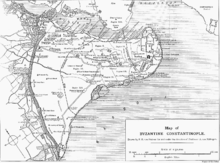Golden Horn
- For the book The Golden Horn by Judith Tarr, see The Hound and the Falcon.
- For the gulf in Vladivostok, see Zolotoy Rog Bay



The Golden Horn (Turkish: Haliç, Greek: Χρυσόν Κέρας – Chrysón Kéras) is an inlet of the Bosphorus dividing the city of Istanbul and forming a natural harbor.
History

According to Greek legend, the Golden Horn derives its name from Keroessa, the mother of Byzas the Megarian, who named it after her. It forms a deep natural harbor for the pensinsula it encloses together with the Sea of Marmara. The Byzantine Empire had its naval headquarters there, and walls were built along the shoreline to protect the city of Constantinople from naval attacks. At the entrance to the Horn, there was a large chain pulled across from Constantinople to the old Tower of Galata (which was known as the Megalos Pyrgos (Great Tower) among the Byzantines) on the northern side, preventing unwanted ships from entering. This tower was largely destroyed by the Latin Crusaders during the Fourth Crusade (1204), but the Geneose built a new tower nearby, the famous Galata Tower (1348) which they called Christea Turris (Tower of Christ).
There were three notable times when the chain across the Horn was either broken or circumvented. In the 10th century the Vikings (Varangians) dragged their longships out of the Bosporus, around Galata, and relaunched them in the Horn; the Byzantines defeated them with Greek fire. In 1204, during the Fourth Crusade, Venetian ships were able to break the chain with a ram. In 1453, Ottoman Sultan Mehmed II, having failed in his attempt to copy the Venetians and break the chain with brute force (indeed, heavily damaging his own ships in the process), instead copied the tactics of the Rus', towing his ships across Galata into the estuary over greased logs.
After the Fall of Constantinople to Fatih Sultan Mehmet, Greek citizens, the Greek Orthodox Church, Jews, Italian merchants, and other non-Muslims began to live along the Horn in the Phanar (Fener) and Balat districts. Today the Golden Horn is settled on both sides, and there are parks along each shore. The Istanbul Chamber of Commerce is also located along the shore, as are Muslim, Jewish and Christian cemeteries. The Galata Bridge connects the districts of Galata and Eminönü. Two other bridges, the Atatürk Bridge and the Haliç Bridge, are located further up the Horn. Until the 1980s the Horn was inquinated with industrial waste, but has since been cleaned up and is a popular tourist attraction in Istanbul because of its history and beauty.
Geology
The Golden Horn is a flooded prehistoric estuary.
Leonardo's bridge
In 1502 Leonardo da Vinci produced a drawing of a single span 720-foot (240 m) bridge over the Horn as part of a civil engineering project for Sultan Bayezid II. The vision was resurrected in 2001 when a small footbridge of Leonardo's design was constructed near Aas in Norway.
On May 17, 2006, it was announced that the prime minister of Turkey Recep Tayyip Erdoğan and the mayor of Istanbul Kadir Topbaş had decided to resurrect the Leonardo da Vinci Bridge project. The urban planning and feasibility studies of the project had started earlier, in 1999. After five centuries, Leonardo da Vinci's bridge will span the Golden Horn, becoming the first architectural project of the Renaissance genius to be realized in its original scale and its planned location.
The Turkish architect in charge of the construction is Bülent Güngör, known for the restoration of the Çırağan Palace, the Yıldız Palace, and the Sümela Monastery. The Bridge will be an exact copy of da Vinci's design, with a single span of 720-foot (240 m), a width of 8 metres, and a height above the Golden Horn of 24 metres, as shown on his sketches.
Literature
The Golden Horn features in many works of literature dealing with classical themes. For example, G. K. Chesterton's poem Lepanto contains the memorable couplet "From evening isles fantastical rings faint the Spanish gun, And the Lord upon the Golden Horn is laughing in the sun".
Trivia
The Golden Horn hosted the 4th round of the Red Bull Air Race World Series for the first time on July 29, 2006.
